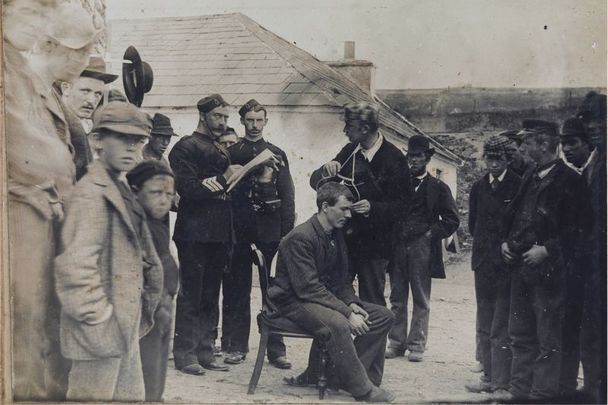Trinity College Dublin is to return human remains to the island of Inishbofin off the coast of Co Galway from where they were taken without the community’s consent more than a century ago.
Trinity's Board of the University approved the decision on February 22 following a period of research, analysis, and public consultation about the future of the remains overseen by the Trinity Legacies Review Working Group.
A Trinity spokesperson said on Wednesday that further engagement will now take place with the Inishbofin community to identify the appropriate way of returning the remains.
Trinity is set to return human remains to the island of Inishbofin, as Provost @LindaDoyle expresses thanks to the community.
Read more here: https://t.co/VcOGeC77MW pic.twitter.com/pZI3lOHUMX
— Trinity College Dublin (@tcddublin) February 22, 2023
Trinity Provost Dr. Linda Doyle said on Wednesday: “I am sorry for the upset that was caused by our retaining of these remains and I thank the Inishbofin community for their advocacy and engagement with us on this issue.
“We will now work with the community to ensure that the remains are returned in a respectful manner and in accordance with the community’s wishes.
“I want to thank everyone who engaged with the process that we have put in place to address issues of this nature. I am glad that we have made an evidence-based decision and that our process allowed all points of view to be heard.”
The Senior Dean and Chair of Trinity Legacies Review Working Group Prof. Eoin O’Sullivan said: “The evidence-based process Trinity has engaged in has, we believe, proved its worth.
"The Trinity Legacies Review Working Group will continue to engage with Trinity’s legacy issues on a case-by-case basis.”
Marie Coyne, an Inishbofin islander who had been campaigning for the return of the human remains, told Sky News: "I'm over the moon, it's like I can breathe out at last.
"We've had a lot of obstacles in the way. I was always hoping, but there were a lot of hopes dashed along the way.
"It's been a long, long time. It's taken a lot of energy and emotion, but this is what they [the skulls] deserve. They were stolen from us."
Coyne added: "We'd like it done as soon as possible.
"It'll be one funeral we'll all be looking forward to going to. We're just so glad they're coming home."

Love Irish history? Share your favorite stories with other history buffs in the IrishCentral History Facebook group.
In July 1890, ethnologist Alfred Cort Haddon and student Andrew Francis Dixon (subsequently Trinity’s Professor of Anatomy), took partial skeletal remains of 13 people from St. Colman’s monastery in Inishbofin.
As is clearly documented in Haddon’s diary of the time, they did not seek the community’s consent:
"We two climbed over the gate, went down the enclosure which is practically a large graveyard, disturbing some cattle, stumbled along and entered the church, tumbling over the grave stones.
"In the corner we saw by the dim light the skulls in a recess in the wall. There must have been 40 or more, all broken, mostly useless, but we found a dozen which were worth carrying away, only one however having the face bones.
"Whilst we were thus engaged we heard 2 men slowly walking along the road and like Brer Fox we lay low and like the Tar Baby, 'kept on saying nothing'.
"When the coast was clear we put our spoils in the sack and cautiously made our wat back to the road. Then it did not matter who saw us. The sailors wanted to take the sack when we got back to the boat but Dixon would not give it up and when asked what was in it said 'Potheen'. So without any further trouble we got the skulls aboard and then we packed them in Dixon's portmanteau and locked it and no except our two selves had an idea that there are a dozen human skulls on board and they shan't know either."
Since then, the remains have been stored in Trinity College Dublin. The context for this, Trinity says, was a contemporary interest in fields including craniometry (measurement of the cranium) and anthropometry (scientific measurement of individuals).
The Inishbofin remains are the first case to be considered by Trinity’s Legacies Review Working Group whose role is to collate and document evidence on legacy issues and whose terms of reference can be read here.
Trinity’s Legacies Review Working Group, comprising Trinity students, professional staff, academic staff as well as external members, commissioned an evidence-based review of the issues around the crania late last year. The Working Paper by Dr. Mobeen Hussain, Dr. Ciaran O’Neill, and Dr. Patrick Walsh from the Department of History, School of Histories and Humanities, was published on 23 November 2022.
At this time, Trinity also invited evidence-based submissions from the public on the future of the human remains from Inishbofin. It received 13 submissions, including a submission from the vast majority of the Inishbofin islanders. To read all public submissions on the issue, see here.
The National Museum of Ireland (NMI) was consulted on the matter. The NMI in its statutory role, determined it did not have a specific jurisdiction on this case, or foresee any legal impediments to reburial under the NMI’s role as outlined in the National Monuments Act 1930 to 2014. It clarified that as the crania was removed in 1890, their removal pre-dates the relevant legislation (National Monuments Act, 1930) and therefore the question of State ownership does not arise.




Comments